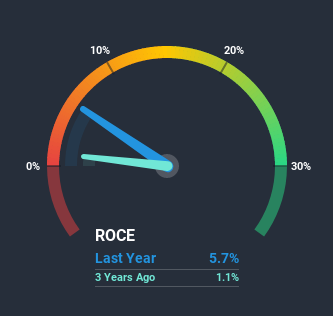Here’s What’s Happening With Returns At Biglari Holdings (NYSE:BH.A)
What trends should we look for it we want to identify stocks that can multiply in value over the long term? In a perfect world, we'd like to see a company investing more capital into its business and ideally the returns earned from that capital are also increasing. Ultimately, this demonstrates that it's a business that is reinvesting profits at increasing rates of return. So when we looked at Biglari Holdings (NYSE:BH.A) and its trend of ROCE, we really liked what we saw.
What is Return On Capital Employed (ROCE)?
For those that aren't sure what ROCE is, it measures the amount of pre-tax profits a company can generate from the capital employed in its business. The formula for this calculation on Biglari Holdings is:
Return on Capital Employed = Earnings Before Interest and Tax (EBIT) ÷ (Total Assets - Current Liabilities)
0.057 = US$40m ÷ (US$984m - US$288m) (Based on the trailing twelve months to September 2020).
So, Biglari Holdings has an ROCE of 5.7%. In absolute terms, that's a low return, but it's much better than the Hospitality industry average of 4.1%.
View our latest analysis for Biglari Holdings
Historical performance is a great place to start when researching a stock so above you can see the gauge for Biglari Holdings' ROCE against it's prior returns. If you want to delve into the historical earnings, revenue and cash flow of Biglari Holdings, check out these free graphs here.
What The Trend Of ROCE Can Tell Us
Biglari Holdings has not disappointed in regards to ROCE growth. We found that the returns on capital employed over the last five years have risen by 124%. The company is now earning US$0.06 per dollar of capital employed. Speaking of capital employed, the company is actually utilizing 27% less than it was five years ago, which can be indicative of a business that's improving its efficiency. If this trend continues, the business might be getting more efficient but it's shrinking in terms of total assets.
For the record though, there was a noticeable increase in the company's current liabilities over the period, so we would attribute some of the ROCE growth to that. Essentially the business now has suppliers or short-term creditors funding about 29% of its operations, which isn't ideal. Keep an eye out for future increases because when the ratio of current liabilities to total assets gets particularly high, this can introduce some new risks for the business.
The Bottom Line
From what we've seen above, Biglari Holdings has managed to increase it's returns on capital all the while reducing it's capital base. Astute investors may have an opportunity here because the stock has declined 16% in the last year. With that in mind, we believe the promising trends warrant this stock for further investigation.
Like most companies, Biglari Holdings does come with some risks, and we've found 1 warning sign that you should be aware of.
While Biglari Holdings isn't earning the highest return, check out this free list of companies that are earning high returns on equity with solid balance sheets.
This article by Simply Wall St is general in nature. It does not constitute a recommendation to buy or sell any stock, and does not take account of your objectives, or your financial situation. We aim to bring you long-term focused analysis driven by fundamental data. Note that our analysis may not factor in the latest price-sensitive company announcements or qualitative material. Simply Wall St has no position in any stocks mentioned.
Have feedback on this article? Concerned about the content? Get in touch with us directly. Alternatively, email editorial-team (at) simplywallst.com.

